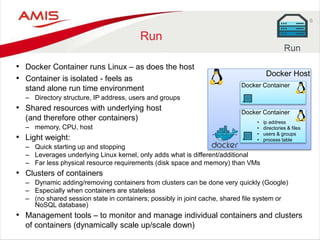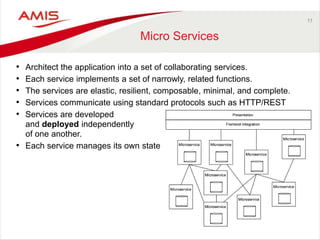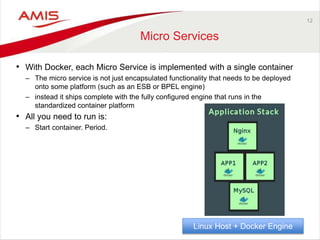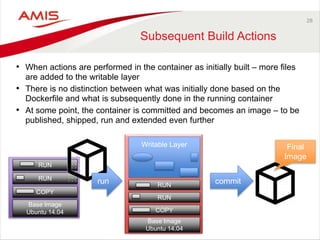Java developer intro to environment management with vagrant puppet and docker
- 1. Lucas Jellema JavaOne 2015, San Francisco, 26th October 2015 Java Developer Intro to Environment Management with Vagrant, Puppet, and Docker
- 3. 3 Who are you? • Developer or Administrator – Java, Oracle, Web, NoSQL, … – Perhaps on a non-Linux laptop • Limited physical computer resources – CPU, Memory, Disk Space • Inclined to try out new stuff – frameworks, tools, products, … – Quickly, smoothly, without messing up your environment • Create things you want to share – Without creating elaborate instructions for installing and configuring – Without discussions around ‘it works on my machine’ , ‘send me your config files’ • Interested in running stuff on “the cloud” • No Linux allergy • Interested in ‘that Docker thing’ • (a bit like me)
- 4. 4 This session will give you • What is this Docker thing and why is it a hype? • How do Containers compare to Virtual Machines? • How can I build, ship [| share | distribute] and run containers? – On my local machine and in the cloud? • A way to more efficiently leverage the physical resources in my computer? – than through juggling VMs • A structured and fast way to try out new software – Without messing up my local environment. • What tools do I need to get started with Docker on my non-Linux laptop? • What is the status of Docker and where is it going? • How can I get going on my own with Docker?
- 5. 5 Supporting Materials • The slides for this presentation • All demo scripts • Extended slides with more details and examples • Workshop Introduction Docker + Vagrant + Puppet SOME TINY URL:
- 6. 6 Run • Docker Container runs Linux – as does the host • Container is isolated - feels as stand alone run time environment – Directory structure, IP address, users and groups • Shared resources with underlying host (and therefore other containers) – memory, CPU, host • Light weight: – Quick starting up and stopping – Leverages underlying Linux kernel, only adds what is different/additional – Far less physical resource requirements (disk space and memory) than VMs • Clusters of containers – Dynamic adding/removing containers from clusters can be done very quickly (Google) – Especially when containers are stateless – (no shared session state in containers; possibly in joint cache, shared file system or NoSQL database) • Management tools – to monitor and manage individual containers and clusters of containers (dynamically scale up/scale down) Docker Host Docker Container Docker Container • ip address • directories & files • users & groups • process table
- 7. 7 Demo – Run our first Docker container based on the nginx image
- 8. 8 Demo –running NGINX container; with port forwarding port 80 port 90 IP 172.17.0.7
- 9. 9 Demo: run container for Ubuntu image in interactive mode using shell dockerhost /tmp/mynewfile.txt
- 10. 10 Demo: restart container and attach to it and locate my file dockerhost /tmp/mynewfile.txt
- 11. 11 Micro Services • Architect the application into a set of collaborating services. • Each service implements a set of narrowly, related functions. • The services are elastic, resilient, composable, minimal, and complete. • Services communicate using standard protocols such as HTTP/REST • Services are developed and deployed independently of one another. • Each service manages its own state
- 12. 12 Micro Services • With Docker, each Micro Service is implemented with a single container – The micro service is not just encapsulated functionality that needs to be deployed onto some platform (such as an ESB or BPEL engine) – instead it ships complete with the fully configured engine that runs in the standardized container platform • All you need to run is: – Start container. Period. Linux Host + Docker Engine
- 13. 13 Ship (Container Images) • Package, Distribute, Share, Publish and Consume container images – The frozen state of a container (committed after building and further manipulating) – With everything needed to run the micro service: application and underlying platform & OS, ready to run on any Docker Engine anywhere – With an implicit interface (environment variables, link, volume)
- 14. Public Docker Registry Docker Hub 14 Docker Image Registry push Private Docker Registry Docker Hub push
- 15. 15 Docker Registry • Images can be published to Public and Private Registries – Docker Hub is the default registry – Docker Hub contains official repositories from many projects and vendors – Private Registries can be created in the cloud and on premises • Containers can be started from such images
- 16. 16 Implicit Image Interface: environment variables, link, volume Docker Hub link mysql Parameters: WORDPRESS_DB_PASSWORD, WORDPRESS_DB_USER, … Volume ..:/var/lib /mysql Parameters: MYSQL_DATABASE, MYSQL_ROOT_PASSWORD
- 17. 17 Demo Ship Run MySQL and Wordpress
- 18. 18 Running Wordpress instance by pulling two public images port 8080 port 80 dockerhostvm IP: 10.10.10.29 Docker Hub
- 19. 19 Commit container as image and push to registry dockerhostvm Docker Hub /tmp/mynewfile.txt Dockersig-trial:1.0
- 20. 20 Image published on public Docker Hub registry
- 21. 21 Run container based on my published image dockerhostvm Docker Hub /tmp/mynewfile.txt Dockersig-trial:1.0 Dockersig- trial:1.0
- 22. 22 How to Ship a Stand-Alone product? • Create Installers + Configuration Instructions? • Make your product success dependent on platform configuration and OS settings? • Ship as a container – everything set up and ready to run! • For example: – RubiconRed – Preferred way to deliver their tool MyST: as Docker Container (image)
- 23. 23 Ship to Cloud • Ship Image to [Run on] Cloud – All product installation, configuration, custom software deployment and testing has been done – all we need is a place for it to land – Complete environment, ready to run on any Docker enabled platform • Many public cloud providers support running Docker Containers Public Docker Registry Docker Hub
- 24. 24 CD = Container Delivery • Why not make continuous software delivery include the container as well? – Automated build does not just build the software but the container as well – The delivered artifact is the container image – The Test and Acceptance Environment are by definition the same as the development environment – because they are the container
- 25. 25 Containers are built on layers • Containers (and Container Images) are collections of files in a Docker controlled file system • Files are copied-on-write in this file system – and shared until then • (read only) Images are shared across all containers run from them – And also shared across images built on top of them • The Docker host running the below 9 containers has – 5 containers sharing the same Ubuntu 14.04 image (188 MB once, not 5 times!) – 4 containers sharing the same CentOS 7 image Image Ubuntu 14.04 Tomcat My Simple Container Image CentOS 7 NGINX Node.js MySQL web app 13rd party app 2 IAM X mydbY Z
- 26. 26 Running a Container adds a Writable Layer • A container is run from a predefined Image – This image can be local – possibly used by an existing container or image • Running a Container entails adding a container specific Writable Layer to the stack of reuable image layers • Copy on write: edit or create a file and it gets copied to the writable layer • A container can be stopped – the writable layer is saved and preserved – When the container is restarted, the writable layer is activated • A container can be committed as image – the writable layer becomes part of the new image – and is what the new image adds Image Ubuntu 14.04 TomcatNGINX 3rd party My Web App Container server.xml server.xml My Web App Image server.xml My Web App Container
- 27. 27 Building a Docker Container • Dockerfile specifies all build steps – With fairly low level commands • Start from base image - each step in the Docker Script adds a layer • A layer is a logical ‘savepoint’ in the container history – That marks an intermediate ‘image’ – A physical directory somewhere on the Docker Host • The build context contains all files available during the build process – Note that additional files can be downloaded (e.g. HTTP with wget and Linux package updates with apt-update) FROM Ubuntu:14.04 COPY RUN WORKDIR RUN EXPOSE CMD COPY RUN RUN Image Ubuntu 14.04 Build context Final Image Intermediate Image
- 28. 28 Subsequent Build Actions • When actions are performed in the container as initially built – more files are added to the writable layer • There is no distinction between what was initially done based on the Dockerfile and what is subsequently done in the running container • At some point, the container is committed and becomes an image – to be published, shipped, run and extended even further Base Image Ubuntu 14.04 COPY RUN RUN Base Image Ubuntu 14.04 COPY RUN RUN Writable Layer run commit Final Image
- 29. Standard Image, locally built 29 Build • In addition to 10Ks of reusable images to start containers from • There are a zilion Dockerfiles to leverage for building images – Download script – Add software packages and installers (because of license reasons) – Tweak the script to fit your own needs OR (preferably) – Run the script, create a local image and then create your own Docker File that takes this image as its starting point Your Own Dockerfile Your Tweaked Image
- 30. 30 “Docker” Search results on GitHub
- 31. 31 Demo Build
- 32. 32 Demo run container after build
- 33. 33 Image and Container Specifics Container Base Image Ubuntu 14.04 COPY RUN RUN Writable Layer run Container “state” tag remove inspect save tar load … pullregistry
- 34. 34 Image and Container Specifics Container Base Image Ubuntu 14.04 COPY RUN RUN Writable Layer run start attach (un)pause kill stop restart remove inspect logs Container “state” export tar … Flattened, no image details
- 35. 35 Container Details & Operations Container web Container db link docker run –it <image-id> /bin/bash Container xxx link link 808080 /tmp/files Shared Files /data /host_files Docker storage /software Shared Files /repos/repos 1 2 3 4 1 2 3 4 2 4 –p 8080:80 -v /data -v /tmp/files:/host_files -volumes-from xxx --name web --link db:db1 –link xxx:web_xxx
- 36. 36 For example: build container for Oracle WebLogic • Clone from GitHub to Docker host – Dockerfile – Shell scripts – Supporting files • Download RPMs for – JDK 8 – WebLogic 12.1.3 • Docker Build • Optionally use second Docker file on top of WebLogic image to create a WLS Domain Standard Oracle WebLogic Image, locally built
- 37. 37 Build File for WebLogic Base Image Oraclelinux:7 RUN COPY RUN COPY COPY COPY
- 38. 38 Build File for WebLogic (2) Base Image Oraclelinux:7 RUN COPY RUN COPY COPY COPY RUN RUN RUN RUN RUN
- 39. Base Image Oraclelinux:7 RUN COPY RUN COPY COPY COPY RUN RUN RUN RUN RUN 39 Turn container into image Base Image Oraclelinux:7 RUN COPY RUN COPY COPY COPY RUN RUN RUN RUN RUN docker commit <container-id> weblogic:12.1.3-dev
- 40. 40 Automated Configuration Management • Use of (hard coded, environment specific) Shell Scripting to create | compose | configure environments is not exactly the latest fashion • Declarative, automated configuration management tools have us specify what we need and then make that happen – No scripting – Cross platform – Parametrized – Leveraging public catalogs of environment definitions
- 41. Container Build process • Regular Docker Build – From base image – Add Puppet support – Add Puppet Manifests & Modules • Start Container – Optional: Map Volume from host with large files – Run Puppet to apply Manifests – Perform additional actions in container – Stop Container, Commit as Image • Push/Ship new image • Run containers from final image dockerhostvm Dockerfile my-base-container /files /puppet /files volume 1 Very big files Proposed workflow for building Docker Container Images 2 3 4 5 4 21 3 /puppet Manifests/Modules 5 7 7 Base Image Oraclelinux:7 RUN COPY RUN COPY COPY COPY RUN RUN RUN RUN RUN 6 6 88 9 9
- 42. 42 Notes on Using Puppet with Docker • After applying Puppet – the container can be stopped, tagged and used as base image for next Docker Build – That could add EXPOSE, ENV, CMD or ENTRYPOINT • With some workarounds, Puppet apply can be made to run during Docker Build (with RUN in Dockerfile) – Less control over build context – No Volume mapping from host • There are Puppet Modules to use for automating the build pipeline of Docker (leveraging the Docker API) – To install Docker, build container, create and ship an image, run container • What applies to Puppet by and large applies to similar tools such as Chef, Salt and Ansible • Puppet Modules are available for many Oracle Database & Fusion Middleware configuration management tasks – Oracle Database (EE, SE, XE) – WebLogic, SOA Suite, OSB, BPM Suite, WLST – JDK, Opatch, VirtualBox, GlassFish, Hudson, Maven
- 43. 43 Demo build with Puppet
- 44. 44 Run GUI applications in Docker Container Container docker run –d –it -v /tmp/.X11-unix:/tmp/.X11-unix -e DISPLAY=$DISPLAY <image-id> /bin/bash /tmp/.X11-unix /tmp/.X11-unix dockerhost GUI applications
- 45. 45 Docker and Windows • Docker sits on Linux Containers – Windows Server 2016 will have containers too – and Docker will sit on those as well – However, today, Docker does not run on Windows (nor on )
- 46. 46 Docker cannot run on Windows - directly dockerhost Container Container Container
- 47. 47 Docker cannot run on Windows - directly, without Linux VM dockerhost Container Container Container
- 48. 48 Vagrant to the rescue dockerhost Container Container Container
- 49. 49 Vagrant to the rescue • Based on simple declarative definitions… • Vagrant provisions environments through various providers – VirtualBox, VMware, AWS • Subsequently, provisioning (‘configuration management’) using shell scripts, Chef, Ansible, Salt or Puppet • Vagrant supports Docker – Create Docker Host VM, Build | Run | Manage Container • Vagrant makes host-container folder mapping and networking quite easy dockerhost Container
- 50. dockerhostvm 50 Vagrant Docker Provisioning • Vagrantfile defines the Container to run – including name and initial command and also synched folders (i.e. host <=> container mapping) • Dockerfile contains build recipe for the Container we want to build • DockerHostVagrantfile describes the VM to be used as Docker Host Vagrantfile DockerHostVagrantfile Dockerfile my-little-container other-container some-container
- 51. 51 Vagrant Docker Provisioning dockerhostvm Vagrantfile DockerHostVagrantfile Dockerfile my-little-container build process Docker Hub ubuntu:14.04 /u01/readme.txt Vagrant Boxes ubuntu/trusty64
- 52. 52 Vagrant with Docker Folder Mapping dockerhostvm Vagrantfile DockerHostVagrantfile my-little-container /vagrant /vagrant /host_temp /host_data /var/lib /docker /docker_ generatedId
- 53. 53 Demo – Run Docker Containers with Vagrant • This entire session was Vagrant based! • Vagrant: – Configures Windows Host/Container Folder mapping and Host VM IP Settings – Can stop and start as well as create and destroy containers • Note: docker-run and docker-logs are special Vagrant commands – For one-off command in container and to get insight in what happens in the container
- 54. 54 Docker on Windows – other options • Docker Toolbox (since August 2015) replaces Boot2Docker – Contains Docker Client for Windows, Kitematic (Docker GUI, alpha release), Docker Machine, Docker Engine and leverages Oracle VirtualBox – Still uses Boot2Docker Linux Distribution to run containers – No support for GUI in containers
- 55. 55 Docker Containers Status & Future • Growing adoption beyond innovators and [very] early adopters • Growing number of tools around Docker – Monitoring, Management, Clustering, … • Windows – support for containers in Windows 2016 • Solaris Zones to work with Docker Client • Cloud Support – By a fast evolving number of IaaS/PaaS cloud providers – AWS, Azure, Google Container Engine • Open Container Initiative • docker.con (EU)
- 56. 56 Oracle and Docker • Oracle Linux 6 and 7 Images • Oracle MySQL image • WebLogic certified on Docker – Official “Docker Build-scripts in GitHub to create images” • Solaris Zones leveraged by Docker Engine • Participate in OCI • Docker on Oracle Cloud??
- 57. 57 Summary • Docker helps you run isolated environments in a quick, lean way – Containers are far more light weight, yet almost as stand alone as VMs – Hundreds of official Docker Container base images are publicly available • Docker Containers are micro services – with an exposed interface to inject dependencies (volume, link, environment settings) • Share | Distribute | Publish your complete, working environments is very easy using Docker container images – Either push to registry or save as TAR • CD could become ‘Container Delivery’ – deliver software + environment • Many cloud providers can run Docker Containers • Do not attempt to build containers completely from Dockerfile – Leverage declarative configuration management tools such as Puppet and Chef • Tools like Vagrant allow you to easily work with Docker on a non-Linux host
- 58. 58 What did you get from this session? • What is this Docker thing and why is it a hype? • How do Containers compare to Virtual Machines? • How can I build, ship [| share | distribute] and run containers? – On my local machine and in the cloud? • A way to more efficiently leverage the physical resources in my computer? – than through juggling VMs • A structured and fast way to try out new software – Without messing up my local environment. • What tools do I need to get started with Docker on my non-Linux laptop? • What is the status of Docker and where is it going? • How can I get going on my own with Docker? REPEAT SHORT URL FOR RESOURCES
Editor's Notes
- #2: CON2394 The functionality available to Oracle Database developers has evolved over all releases of Oracle Database. The improvements have allowed for faster development, richer functionality, and better-performing code as well as clearly establishing the role of the database in multitier applications and SOA architectures. Areas of recent improvement include core SQL (with inline PL/SQL), flashback, data pattern processing, zero-downtime application upgrades, XML manipulation, JSON support, inbound and outbound HTTP processing, data redaction, fine-grained auditing and authorization, and PL/SQL language extensions. This session demonstrates the most-useful 12c database features for application developers. 12.1.0.2 In Memory, JSON, Approximate Count Distinct, PDB CONTAINERS Clause Flashback Database Archive Support for Multitenant Container Database JSON in Oracle http://t.co/f2bEKQSpwz
- #45: https://technology.amis.nl/2015/08/29/vagrant-docker-virtualbox-and-the-graphical-desktop-for-gui-applications-in-docker-containers/




![4
This session will give you
• What is this Docker thing and why is it a hype?
• How do Containers compare to Virtual Machines?
• How can I build, ship [| share | distribute] and run containers?
– On my local machine and in the cloud?
• A way to more efficiently leverage the physical resources in my computer?
– than through juggling VMs
• A structured and fast way to try out new software
– Without messing up my local environment.
• What tools do I need to get started with Docker
on my non-Linux laptop?
• What is the status of Docker and where is it going?
• How can I get going on my own with Docker?](https://image.slidesharecdn.com/javadeveloperintrotoenvironmentmanagementwithvagrantpuppetanddockerbof2817-151015134724-lva1-app6892/85/Java-developer-intro-to-environment-management-with-vagrant-puppet-and-docker-4-320.jpg)


















![23
Ship to Cloud
• Ship Image to [Run on] Cloud
– All product installation, configuration, custom software deployment and testing has
been done – all we need is a place for it to land
– Complete environment, ready to run on any Docker enabled platform
• Many public cloud providers support running Docker Containers
Public Docker
Registry
Docker Hub](https://image.slidesharecdn.com/javadeveloperintrotoenvironmentmanagementwithvagrantpuppetanddockerbof2817-151015134724-lva1-app6892/85/Java-developer-intro-to-environment-management-with-vagrant-puppet-and-docker-23-320.jpg)































![55
Docker Containers
Status & Future
• Growing adoption beyond innovators
and [very] early adopters
• Growing number of tools around Docker
– Monitoring, Management, Clustering, …
• Windows
– support for containers in Windows 2016
• Solaris Zones to work
with Docker Client
• Cloud Support
– By a fast evolving number of
IaaS/PaaS cloud providers
– AWS, Azure,
Google Container Engine
• Open Container Initiative
• docker.con (EU)](https://image.slidesharecdn.com/javadeveloperintrotoenvironmentmanagementwithvagrantpuppetanddockerbof2817-151015134724-lva1-app6892/85/Java-developer-intro-to-environment-management-with-vagrant-puppet-and-docker-55-320.jpg)


![58
What did you get from this
session?
• What is this Docker thing and why is it a hype?
• How do Containers compare to Virtual Machines?
• How can I build, ship [| share | distribute] and run containers?
– On my local machine and in the cloud?
• A way to more efficiently leverage the physical resources in my computer?
– than through juggling VMs
• A structured and fast way to try out new software
– Without messing up my local environment.
• What tools do I need to get started with Docker
on my non-Linux laptop?
• What is the status of Docker and where is it going?
• How can I get going on my own with Docker?
REPEAT SHORT URL FOR RESOURCES](https://image.slidesharecdn.com/javadeveloperintrotoenvironmentmanagementwithvagrantpuppetanddockerbof2817-151015134724-lva1-app6892/85/Java-developer-intro-to-environment-management-with-vagrant-puppet-and-docker-58-320.jpg)
